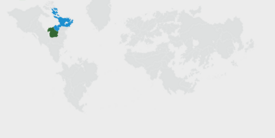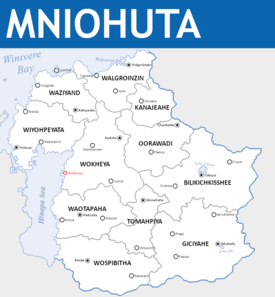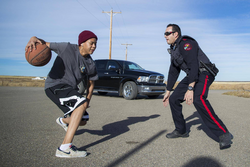Mniohuta: Difference between revisions
No edit summary |
|||
| Line 157: | Line 157: | ||
== Geography == | == Geography == | ||
Making up a total land area of 977,728 km2, Mniohuta is the third smallest country on the Norumbian continent and is geographically central. Along the northern border of the confederacy is Winivere bay and to its West is the Hinapa strait and the | Making up a total land area of 977,728 km2, Mniohuta is the third smallest country on the Norumbian continent and is geographically central. Along the northern border of the confederacy is Winivere bay and to its West is the Hinapa strait and the Hinapa sea. Bodies of water aside, the northern {{wp|Brooks Range|Wazepiya Mountain Range}} is the major defining feature of Mniohuta's north and provides the majority of the country's mineral wealth. In the Southeast are the {{wp|Appalachian Mountains|Osowanon Mountains}} which mark the primary border between Mniohuta and several of its neighbors. The center of the country is largely defined by the {{wp|Missouri River|Thanzanye Basin River System}} which stretches from both mountain ranges down to the nation's southern coastline. To the nation's East across the Hinapa strait is [[Elatia]], to the south is [[Gristol-Serkonos]], to the West is [[Chenes]] and a narrow strip of land connecting it to [[Moxaney]], and to its Northeast is [[Awasin]]. | ||
While the mountains remain prominent geographical features for the nation, the vast majority of the country is enveloped by the {{wp|Great Plains|Thanzanye Plain}}. Running through the central section of the country is the {{wp|Missouri River|Mnisose River}} which runs through Wokheya, and its distributary the {{wp|Osage River|Wazaze River}} which, similar to its parent river, empties into the Hinapa sea. While a majority of the water that flows into the aforementioned rivers comes from the mountains, {{wp|Lake Sakakawea|Lake Oskopa}} and {{wp|Lake Thompson|Lake Ciz}} also serve as major reservoirs that feed into the river system (though they themselves get a majority of their water from mountain snow-melt, glacial melt, and runoff). Lake Oskopa is the largest freshwater lake in the country, occupying roughly 2,158 km2 and reaching a maximum depth of around 706 meters, it is the remnant of a prehistoric lake known as {{wp|Lake Agassiz|Lake Iya}} which at one point connected to the Hinapa sea at the conclusion of the {{wp|Last Glacial Maximum}}. | |||
=== Climate === | === Climate === | ||
Revision as of 14:22, 21 February 2022
Confederation of Mniohuta ᐅᔭᑌ ᒼᓂᐅᐦᑕ 1 official name
| |||
|---|---|---|---|
| Motto: «ᐁᓬ ᖧᐊᑲ ᓬᔪᑎᔦᑭᔭ, ᐅᐘᐁᐃᓬᐊ᙮» "In great endeavour, union." | |||
| Anthem: ᐅᐩᐊᑌ ᐅᓬᐅᐘᐣ Oyáte Olówaŋ "Song of the Nation" | |||
| People's Hymn: ᑭᑭᙾ ᓬuᑕ ᐦᐁᐦᐁᐱᔭ Kikiŋ Luta ȟehépiya "For the Scarlet Hills". | |||
 Location of Mniohuta on Earth. Members of the Norumbian People's Alliance in Blue. | |||
 Political Map of Mniohuta | |||
| Capital | Wokheya | ||
| Largest city | Walgroinzin | ||
| Official languages | Mniyapi | ||
| Recognised regional languages | |||
| Ethnic groups (2020) | [a] | ||
| Religion | List of religions
| ||
| Demonym(s) | Mniohutan Mniohuti (plural) | ||
| Government | Parliamentary federated constitutional monarchy | ||
• Premier | Chaska Chimaka | ||
• Great Chief | Odakota Akecheta | ||
| Legislature | Conclave of the Confederacy | ||
| Conclave of Elders | |||
| Conclave of the People | |||
| Formation | |||
• Event | Around 12,000 BCE | ||
• Founding of Wokheya | 935 BCE | ||
• Asherionic Wars | 1805 | ||
• Articles of Confederation | April 14th, 1822 | ||
• Absorption of the Republic of Waziyand | January 20th, 1846 | ||
• The Spring Constitution | November 3rd, 1865 | ||
| Area | |||
• Total area | 897,115 km2 (346,378 sq mi) | ||
• Water (%) | 5 | ||
| Population | |||
• 2020 census | 29,874,102 | ||
• Density | 30.19/km2 (78.2/sq mi) | ||
| GDP (nominal) | 2020 estimate | ||
• Total | $457,073,760,600 | ||
• Per capita | $15758 | ||
| Gini (2015) | low | ||
| HDI (2015) | very high | ||
| Currency | Mniohutan mazaska (₼) | ||
| Time zone | UTC -5 | ||
| Date format | dd/mm/yyyy | ||
| Driving side | right | ||
| Calling code | +68 | ||
| Internet TLD | .mt | ||
Mniohuta (/mniːoʊhʊtjæ/ muh-nee-O-hu-ta), officially the Confederacy of Mniohuta, is a country in northeastern Norumbia. Its consulates cover a landmass of around 897,115 square kilometers (346,378 square miles), bordered by Elatia to the Northwest across the Hinapa strait, the Hinapa Sea to the West, Winivere Bay to the North, Awasin and Moxaney to the Northeast, Chenes to the West, and Gristol-Serkonos to the South. The majority of the 29,000,000 citizens of Mniohuta live in major cities such as Walgroinzin or in the central plains along the many rivers that snake along the thanzanye plain. Wokheya is the capital of the country while Walgroinzin is the largest and most populous city in the country. Mniohuta is characterised by a largely indigenous population, with a significant Ottonian-Mniohuti creole group, and a handful of other minorities from nearby states.
Various indigenous peoples have inhabited what is now the thanzanye plain since at least 12,000 BCE, remaining largely nomadic until the foundation of what is today Wokheya in 925 BCE by members of the Thituwan tribe and the formation of similar settlements in Mniwa and Oskopa in the following years. Unlike many of its neighbours, the central portion of Mniohuta has never been colonised or settled by a foreign power, with indigenous people living largely undisturbed due to a number of geographic barriers. A handful of Ottonian settlers and fur-trappers made their home on the Northern shore of the country, journeying down from the colony in Wazheganon in search of wealth and open space who formed what is today the consulates of Walgroinzin and Waziyand. While traditionally it was believed that the arrival of the Ottonians was the first contact of indigenous Mniohuti with outsiders, modern historians believe that Haratago nomads and explorers passed through the prairies of central Mniohuta at some point in the 10th or 11th century en route to modern day Elatia and Enyama.
By 1500 BCE, many tribes of the thanzanye plain had organised themselves into proper cooperative city-states which co-existed with a number of still nomadic tribes, both having traditionally tribal governments; though, in the case of the city-states many were beginning to form more complex governments. While conflicts between tribes were not uncommon, evident in the warrior-hunter culture, the states were also marked by their willingness to compromise and settle disputes in less violent manners such as game hunting matches and lacrosse (čháŋškopa) tournaments. This largely amicable culture was reflected in willingness to barter and interact (and in certain cases, integrate) with the Ottonian settlements along the Northern coast. Despite the growing centralisation of Mniohuti city-states, it was not until the arrival of Asherion in the mid-1800s that the idea of creating a proper nation-state was more thoroughly popularised.
Representatives from Mniohuta including the Chief of Wokheya and founder of the confederation, Spotted Eagle (Gleškáŋblí), would participate as delegates in the Federative Republic of Great Norumbia's short-lived legislature before the republic's collapse at the hands of the coalition. Upon his return to Wokheya, Spotted Eagle called for a meeting of the tribes in what would be called the Eight Fires Council, an effort to achieve consensus on the formation of a state and to continue in spirit the revolutionary ideals of Asheiron with Mniohuti characteristics. The Council ended after a month of deliberation with the signing of the Articles of Confederation, formalising the role of Great Chief in the early confederation and allowing the confederacy to send representatives to the Congress of Thessalona to negotiate land claims. From the Congress, the Confederation of Mniohuta was formally recognised as a sovereign state alongside the Republic of Waziyand. A decade later the now largely creole and indigenous Republic of Waziyand was peacefully absorbed into the Confederation, leading soon after to the addition of democratic concessions to the Articles of Confederation which would later lead to the writing of the Spring Constitution (Wiwíla Wóopȟe). Contemporary Mniohutan history has largely been characterised by tensions with Elatia over the ceding of the Wiyopeyata peninsula as a result of a Numerian rebellion, an action reversed in 1993 after unrest in the region lead to a popular movement to rejoin Mniohuta.
The Government of Mniohuta is a libertarian socialist federation in the conclavist and co-operative traditions, with a nationally elected premier who acts as a representative of the nation and presides over the conclave of the people, and a council elected great chief who serves a largely ceremonial and spiritual role within the nation. Since the signing of the Spring Constitution in 1865 a system of conclavism has been a key part of Mniohutan politics, with 580,000 nested conclaves at its base, it is a system that is heavily dependent on almost total participation and consensus of the populace. At the national level Mniohuta has a bicameral legislature with a Conclave of the People and Council of Elders; however, the Conclave of the People has de jure total control over national decision making. The Council of Elders exists in its role largely as an advisory body, with the only real responsibility of the Council being to elect a Great Chief upon the death or recall of the previous and to rubber-stamp legislation.
Because of its political evolutionary path, the traditional economic systems of the early Mniohutan city-states evolved into a system of co-operative economics, with basic-needs traditionally being decommodified and most businesses being a hybrid of consumer and worker cooperatives (or are otherwise owned by the state). Major industries and exports include diamonds, iron, textiles, forest products, shipbuilding, railway engineering, and tourism. Mniohuta ranks highly in international measurements of political freedoms and participation, government transparency, education, and quality of life. International experts consider Mniohuta to be a middle power with a geopolitically strategic and central role on the continent. It is a member of a number of international organisations such as the International Observatory of Labor, Osawanon community, and is a founding member of the Norumbian People's Alliance (Hahowin).
Etymology
The origins of the name Mniohuta stem from the Mniyapi word Mnióhuta (ᒼᓂᐅᐦuᑕ) which roughly translates into english as "Land by the Sea" or "Land of Coasts". The first use of the word Mniohuta was uncovered in a letter from the Third Chief of Wokheya, Lion Chaser (Igmútȟuwá) of the khowakota tribe to Golden Eagle (Wíyamázkazi) of the Mnokiwoju tribe in which he invited his fellow chief to join the settlement "Rest your weary legs, new life springs from our land by the lake like the yarrow from the grasses." The term gradually became synonymous with Wokheya and many of the other settlements and tribes that dotted the shores of the Hinapa Sea, growing more popular as it spread inland through word of mouth of the nomadic tribes moving inland during the summers. While the term Thituwan was more popular for describing the people of the Mniohutan prairies than its modern demonym, describing the land as one by the lake was the most conventional as most tribes would eventually make their way back to it during the winter resting season. In winter counts the name was most frequently recorded, especially in documents after 1258 CE, with the name finding itself equally applicable for the settlements in Skhabela and Oskopa. When first contact was established with Ottonian trappers, the first natives they had encountered were the Waziyaki tribe of the Northern coast, with the trappers using the tribe's name and combining it with the Ottonian word "land" to create Waziyand which became synonymous with Mniohuta as an exonym. Following the adoption of the article of confederation a few formal names were considered, but Mniohuta rose to the top for how general it was and how frequently the term had become and when the delegates arrived at the Congress of Thessalona it became the internationally recognised name of the country. While this was largely done out of the wishes of the Thituwan people, this was also to avoid confusion with then then newly created republic of Waziyand to the North.
Demonyms
While a handful of nicknames for the land persist, there is a general sense of consistency when referring to the country outside of the realm of minority languages such as Wazhewen. In its noun form "Mniohutan" is almost universally considered the preferable term, with the adjective "Mniohuti" largely only being used to describe the population though is sometimes used to replace the noun in certain regional dialects.
Official title
Officially, the country is referred to as the Confederacy of Mniohuta (Mniyapi: Oyáte Mnióhuta, ᐅᔭᑌ ᒼᓂᐅᐦᑕ), a name enshrined in the national constitution since the writing of the first articles of confederacy to officiate their role as a nation state. While Mniohuta has strayed far from its confederal roots and shares far more characteristics with a federation in the modern era, it is still regularly referred to colloquially as "The Confederation" because of its history. While a referendum in 2003 on the matter of removing the title of "Confederacy" from the official title of Mniohuta in exchange for a national prefix such as federation or kingdom, there was very little popular support for the change and it ultimately was voted down by the conclave of the people.
Geography
Making up a total land area of 977,728 km2, Mniohuta is the third smallest country on the Norumbian continent and is geographically central. Along the northern border of the confederacy is Winivere bay and to its West is the Hinapa strait and the Hinapa sea. Bodies of water aside, the northern Wazepiya Mountain Range is the major defining feature of Mniohuta's north and provides the majority of the country's mineral wealth. In the Southeast are the Osowanon Mountains which mark the primary border between Mniohuta and several of its neighbors. The center of the country is largely defined by the Thanzanye Basin River System which stretches from both mountain ranges down to the nation's southern coastline. To the nation's East across the Hinapa strait is Elatia, to the south is Gristol-Serkonos, to the West is Chenes and a narrow strip of land connecting it to Moxaney, and to its Northeast is Awasin. While the mountains remain prominent geographical features for the nation, the vast majority of the country is enveloped by the Thanzanye Plain. Running through the central section of the country is the Mnisose River which runs through Wokheya, and its distributary the Wazaze River which, similar to its parent river, empties into the Hinapa sea. While a majority of the water that flows into the aforementioned rivers comes from the mountains, Lake Oskopa and Lake Ciz also serve as major reservoirs that feed into the river system (though they themselves get a majority of their water from mountain snow-melt, glacial melt, and runoff). Lake Oskopa is the largest freshwater lake in the country, occupying roughly 2,158 km2 and reaching a maximum depth of around 706 meters, it is the remnant of a prehistoric lake known as Lake Iya which at one point connected to the Hinapa sea at the conclusion of the Last Glacial Maximum.
Climate
Biodiversity
History
Evidence of human habitation in what is now Mniohuta dates back to at least DATE BCE. Archaeological records suggest that
First human habitation
Formation of permanent settlements
Asherionic Wars
The Eight Fires Council
The Spring Constitution and Industrialization
The Wiyopeyata Peninsula War
Contemporary History
Government and politics
Premier
Chief of the Council
Mniohuta is a federal, libertarian socialist council republic in the communalist tradition. TEXT TEXT TEXT TEXT.
The Chief of the Council of the House of... premier .
Law
Legal system.
Mniohuta and also description.
Foreign relations
Since the Title and resulting political ...
Military
When the
Constituencies
Description of civil organization and of prefectures(?).
| Commonwealth | Capital | Population | |
|---|---|---|---|
| File:Flag of Walzenia modern.png Mniohuta - Confederacy of Mniohuta | Capital | Population | |
| File:Flag asd.svg Name - Name title | Zorai | 6,201,418 |
Economy
what the.
Agriculture
Energy
Tourism
Transporation
Science and technology
Demographics
With a population of X then Y Template:Largest cities in Mniohuta
Ethnic groups
DESCRIPTION THATS REALLY AWESOME:
- NAME 1: YEAH BABY.
- NAME 2: WHEN WHEN YOU.
Additionally, there are countless immigrant communities which do not fit into any of these groups.
Languages
awesome text.
Religion
Mniohuta time baby..
Education
H.
Health
H.
Culture
1
Architecture
Mnio ysdgjesngewojgweewg.
- Swaglord21 002.jpg
Yeah.
- Wowthatscrazy.jpg
Description.
Cinema
Maybe
Clothing
Swag.
Cuisine
time to talk to hiero.
Holidays
swag day.
Literature
edgar allen ur mom.
Sports
woooo sports ball baby.
- ↑ Since the unification of the eight tribes most of the more minor tribes were absorbed by the larger ethnic groups such as the Thituwan, Hetuwa, Mniwa, or were already fairly closely related.









